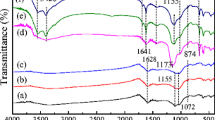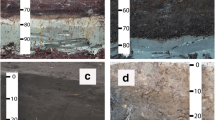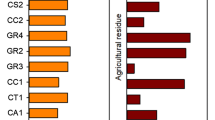Abstract
Biochar is an organic carbon (OC) and plant nutrient-rich substance that may be an ideal amendment for bolstering soil organic matter and nutrient contents. Two biochars were produced by pyrolysis at 350 °C from pine chips (Pinus taeda) and swine manure solids (Sus scrofa domesticus). The biochar total elemental composition was quantified using inductively coupled plasma spectrometer and their surface chemical composition examined using a combination of scanning electron microscopy (SEM) and electron dispersive spectroscopy (EDS). The biochars were mixed into triplicate pots containing Lauderhill muck (Euic, hyperthermic Lithic Haplosaprist) at 0, 2.5, 5, and 10 % (dry mass). Four simulated water infiltration events were conducted during the 124-day incubation to assess the potential alteration in the leaching potential of soluble soil nutrients. At termination, the muck’s fertility characteristics were assessed, and dissolved cations were measured in water leachates. Neither biochars significantly increased the muck’s OC contents. Swine manure biochar contained higher K, Mg, Na, and P concentrations, and these differences were observable in SEM and EDS as differing amounts of surface-precipitated Mg and K salts. Correspondingly, swine manure biochar at all three applications rates significantly increased Mehlich 1-s K, P, Mg, and Na concentrations. Pine chip biochar only improved the Mehlich 1-extractable K concentration but did reduce soluble P concentrations. Water leachates from swine manure biochar treated wetland soil contained significantly higher soluble P concentrations that could create water quality issue in downstream ecosystems.


Similar content being viewed by others
References
ASTM. (2006). Petroleum products, lubricants, and fossil fuels: gaseous fuels, coal, and coke. West Conshohocken: American Society for Testing and Materials.
Ballantine, K., Schneider, R., Groffman, P., & Lehmann, J. (2012). Soil properties and vegetative development in four restored freshwater depressional wetlands. Soil Science Society American Journal, 76, 1482–1495.
Barnea, I., Litaor, M. I., & Shenker, M. (2012). Evaluation of phosphorus management practices in East Mediterranean altered wetland soils. Soil Use and Management, 28, 35–44.
Daroub, S.H., Stuck, J.D., Lang, T.A., & Diaz, O.A. (2002). Particulate phosphorus in the Everglades Agricultural Area: II. Transport mechanisms. Institute of Food and Agricultural Sciences, Univ. of Florida. Gainesville. Available at: http://www.edis.ifas.ufl.edu/SS417. Accessed on December 12, 2013.
Grove, C., & Jerram, D. A. (2011). jPOR: an image J macro to quantify total optical porosity from blue-stained thin sections. Computer Geosciences, 37, 1850–1859.
Ingebritsen, S.E., McVoy, C., Glaz, B., & Park. W. (2013). Florida Everglades: subsidence threatens agriculture and complicates ecosystem restoration. In: Galloway, DL., D.R. Jones, & S.E. Ingebritsen, (eds), Land Subsidence in the United States: U.S. Geological Survey Circ. 1182. pp. 95–106.
Janssen, C., Wirth, R., Reinicke, E., Naumann, R., Wenk, H.-R., & Dresen, G. (2011). Nanoscale porosity in SAFOD core samples (San Andreas Fault). Earth Planetary Scientific Letters, 301, 179–189.
Laird, D., Fleming, P., Wang, B., Horton, R., & Karlen, D. (2010). Biochar impact on nutrient leaching from a Midwest agricultural soil. Geoderma, 158, 436–442.
Litaor, M. I., Eshel, G., Sade, R., Rimmer, A., & Shenker, M. (2008). Hydrogeological characterization of an altered wetland. Journal of Hydrology, 349, 333–349.
Mengel, K., & Kirkby, E. A. (2001). Principals of plant nutrition. Bern: Springer.
Novak, J. M., Busscher, W. J., Laird, D. L., Ahmedna, M., Watts, D. W., & Niandou, M. A. S. (2009). Impact of biochar amendment on fertility of a southeastern coastal plain soil. Soil Science, 174, 105–112.
Novak, J. M., Cantrell, K. B., & Watts, D. W. (2013). Compositional and thermal evaluation of lignocellulosic and poultry litter chars via high and low temperature pyrolysis. Bioenergy Research, 6, 114–130.
Rice, R. W., Izuno, F. T., & Garcia, R. M. (2002). Phosphorus load reductions under best management practices for sugarcane cropping systems in the Everglades Agricultural Area. Agricultural Water Management, 56, 17–39.
Rice, R.W., Gilbert, R.A., & McCray, J.M. (2010). Nutritional requirements for Florida sugarcane. University of Florida Extension Bulletin No. SS-AGR-228. Available at: http://ledis.ifas.ufl.edu/pdfiles/sc/sc02800.pdf. Accessed on 13 December 2013.
Singh, B., Singh, B. P., & Cowie, A. L. (2010). Characterization and evaluation of biochars for their application as a soil amendment. Australian Journal of Soil Research, 48, 516–525.
Snyder, G.H., Burdine, H.W., Crockett, J.R., Gascho, J.G., Harrison, D.S., Kidder, G., Mishoe, J.W., Myhre, D.L., Pate, F.M., & Shih, S.F. (1978). Water table management for organic soil conservation and crop production in the Florida Everglades. University of Florida Institute Food Agricultural Science Technical Bulletin, 801. pp-1-22.
Stephens, J. C. (1956). Subsidence of organic soils in the Florida Everglades. Soil Science Society of America Journal, 20, 77–80.
Stephens, J. C. (1969). Peat and muck drainage problems. Journal of the Irrigation and Drainage Division of the American Society of Civil Engineers, 95, 285–305.
Stephens, J.C., Allen, L.H., & Chen. E. (1984). Organic soil subsidence. In: T.L. Holzer (ed.). Man-induced land subsidence. Geological Society of America Reviews in Engineering Geology, 6:107–122.
Tate, R. L. (1979). Microbial activity in organic soils as affected by soil depth and crop. Applied and Environmental Microbiology, 37, 1085–1090.
USEPA. (1996). Test methods for evaluating solid waste, physical/chemical methods. Methods SW-846, Method 3051A: Microwave assisted acid digestions of siliceous and organically based matrices. Available at http://www.epa.gov/osw/hazard/testmethods/sw846/pdfs/3051A.pdf. Accessed 14 January 2014.
Yao, Y., Gao, B., Zhang, M., Inyang, M., & Zimmermann, A. R. (2012). Effect of biochar amendment on sorption and leaching of nitrate, ammonium, and phosphate in a sandy soil. Chemosphere, 89, 1467–1471.
Acknowledgments
We appreciate the generosity of Dr. Carl Trettin of the United States Forest Service by supplying the pine chip feedstock laboratory assistance by Sheeneka Green and Jerry Martin II with the USDA-ARS-Coastal Plain Research Center, and field support by Velton Banks and Matthew Paige of the Florida Sugar Cane League, Inc., and Jhonnie Tejeda and Juan Tejeda of the USDA-ARS-Sugarcane Field Station at Canal Point, FL. Parts of this work were carried out in the Characterization Facility, University of Minnesota, which receives partial support from the National Science Foundation (NSF) through the Materials Research Science and Engineering Centers (MRSEC) program. There are no conflicts of interests associated with the authors, and the research was accomplished with USDA federal funds.
Disclaimer
Mention of a specific product or vendor does not constitute a guarantee or warranty of the product by the USDA or imply its approval to the exclusion of other products by the USDA or imply its approval to the exclusion of other products that may be suitable.
Author information
Authors and Affiliations
Corresponding author
Rights and permissions
About this article
Cite this article
Novak, J.M., Sigua, G.C., Spokas, K.A. et al. Plant Macro- and Micronutrient Dynamics in a Biochar-Amended Wetland Muck. Water Air Soil Pollut 226, 2228 (2015). https://doi.org/10.1007/s11270-014-2228-y
Received:
Accepted:
Published:
DOI: https://doi.org/10.1007/s11270-014-2228-y




